Estimated reading time 9 minutes, 30 seconds.
In the minds of the general public, all aerial firefighting waterbombers are Canadairs. But in the shadow of the king of the scoop, the Conair Firecat, alias “Turbo Tracker,” does its job with efficiency under the colours of the French Sécurité Civile.
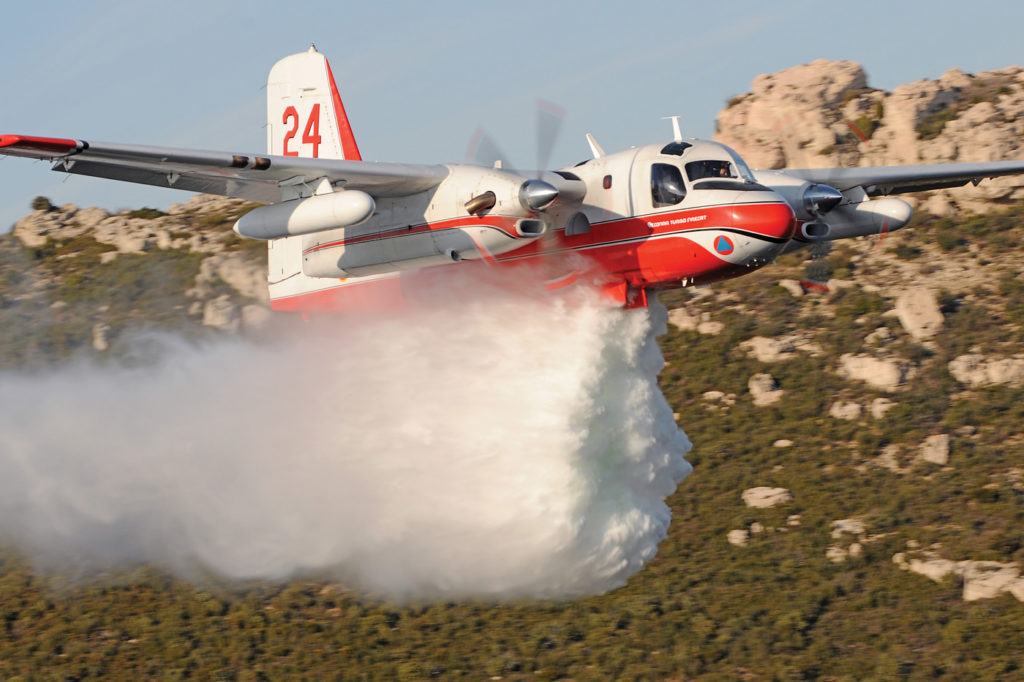
France is the last country to use the airplane on a large scale, currently operating a fleet of nine aircraft which are scheduled for retirement by 2022. While the country has ordered a fleet of six multi-role Bombardier Q400MR airtankers as replacements, it remains business as usual in the nine-aircraft Turbo Firecat department of the Sécurité Civile, led by pilot Philippe Prioult.
Like the other pilots in his department, Prioult is a former military aviator. He spent 15 years with the French Air Force, flying SEPECAT Jaguars and Dassault Mirage 2000Ns. From the strike-fighting Jaguar, he acquired the taste for low-level bombing missions, a skill that transfers nicely to aerial firefighting.
When asked if he has encountered any flaws with the twin-engine Turbo Firecat, Prioult answers “no” without hesitation. Then he changes his mind, well aware that no plane is perfect. “His only fault is his age.”
Indeed, the Firecat’s origins date back to 1952. That’s when Grumman first flew its S-2 Tracker, a twin-engine, carrier-based anti-submarine aircraft that was originally produced for the U.S. Navy.
Grumman built more than 1,200 S-2 aircraft, many of which were designated as military surplus by the 1970s. That’s when a Canadian company, B.C.-based Conair Group, raided the surplus fleet with the idea of developing a firefighting air tanker.
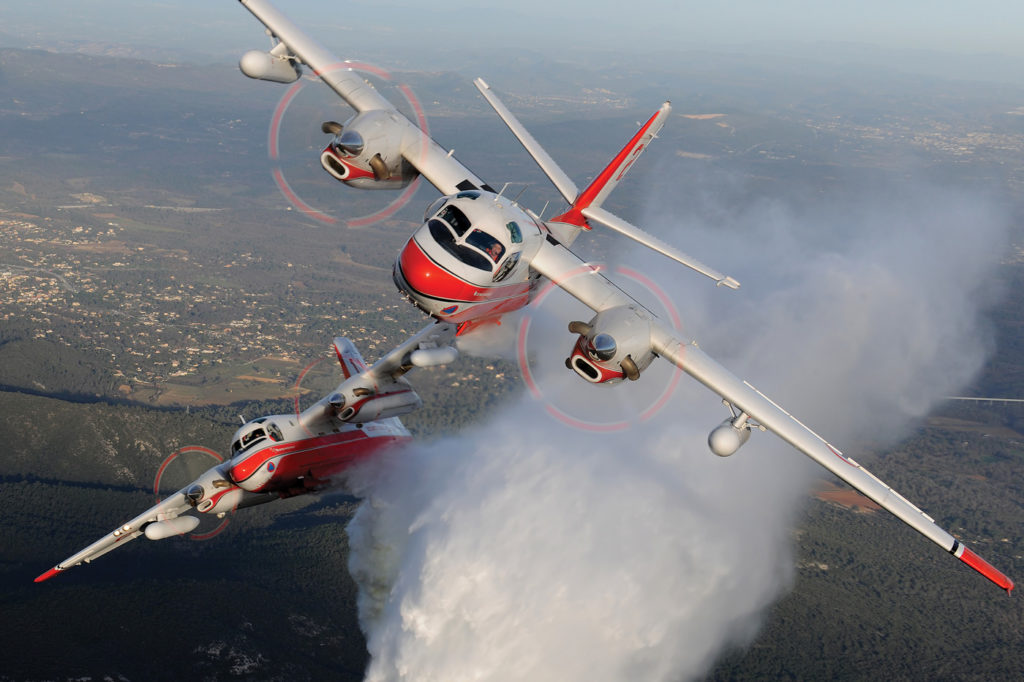
Dubbed the Firecat, Conair achieved its objectives by raising the cabin floor 20 centimetres to accommodate four water tanks in the old bomb bay. At the same time, the removal of all the military equipment translated into a 1,500-kilogram weight savings, allowing for the addition of a 3,296-litre retardant tank.
The French Sécurité Civile opted for the plane in 1981, and the first two aircraft landed in Marignane (Marseille’s international airport in southern France) the following year, after a nine-stop journey from Conair in British Columbia.
Fourteen aircraft were purchased by France, with the last one delivered in 1987. While receiving its last Firecat, the Sécurité Civile engaged in an engine upgrade program that gave birth to the Turbo Firecat, with the old piston engines being replaced with a pair of modern Pratt & Whitney Canada PT6A-67AF turboprops and new five-blade propellers.
Upgraded airplanes were also easily recognizable thanks to the additional fuel tanks permanently suspended under the wings. The Turbo Firecat was also lighter, with a 6,800 kilogram empty weight, since the PT6 turbines were much lighter than the original Wright piston engines.
The upgraded aircraft were further complemented by a handful of Turbo Firecats bought directly from Conair. At the end of the day, the French Sécurité Civile purchased a total of 19 aircraft from the Canadian company. Of this total, eight were subsequently destroyed in operation, one has been retroceded, another has been placed on display, and there are now nine operational aircraft.
OF DIALS AND iPAD
The days of those last nine aircraft are numbered. The first will be retired by the end of 2018, and four more by 2020. All aircraft will stop flying by 2022.

However, for the French pilots, the Turbo Firecat is irreplaceable. When asked to quote the shortcomings of the plane, they do not find any.
The original Tracker was already pretty good, and with the turbines it became nearly perfect–even more flexible and faster while remaining very agile. Admittedly, the available power is relatively limited and the release of the payload (a mixture of water and chemical to suppress a fire) is imperative in the event of engine failure.
Still, it is necessary to push Philippe Prioult to admit to the discomforts of the plane.

“OK, the cockpit is not air conditioned and it’s hot in the summer,” he said. “The cockpit is clamped between the two engines and the lack of soundproofing also makes it a noisy airplane. One flies with earplugs and helmet, but it remains very noisy . . .”
Another unique feature of the plane is the cockpit access via a hatch located on top of the fuselage. The pilot must be fit!
The dashboard is classic, based on dials and without screens. But the Sécurité Civile pilots now fly with an iPad on their lap to assist with navigation. Turbo Firecats, however, only operate in daylight, in specific sectors.
KING OF THE AERIAL PATROL
The aircraft is compact, drawing its lines from its original mission (the hunt for submarines) and the constraints arising from its embarkation on aircraft carriers. Its dimensions allowed it to sit on an elevator and enter an aircraft carrier hangar, while having at the same time a well-sized tail to counter an engine failure.
It also had to be sufficiently manoeuvrable at low speeds for carrier operations, which resulted in the use of very large flaps–these occupy 80 per cent of the trailing edge of the wing. The remaining 20 per cent is occupied by the ailerons, whose action is combined with that of the spoilers (1.5 metres on each wing). This provides excellent manoeuvrability to the aircraft, and a stall speed of only 70 knots.
The Turbo Firecat weighs 20,000 pounds including 4,000 pounds of fuel (two main tanks of 1,700 pounds each plus 300 pounds per underwing tank). With the 7,500 pounds of water and fire retardant mixture carried in its four payload tanks, the aircraft reaches the maximum takeoff weight of 27,500 pounds. The payload tanks are filled on the ground under pressure in less than two minutes. The “bombing” is generally done in two stages, two tanks at a time.
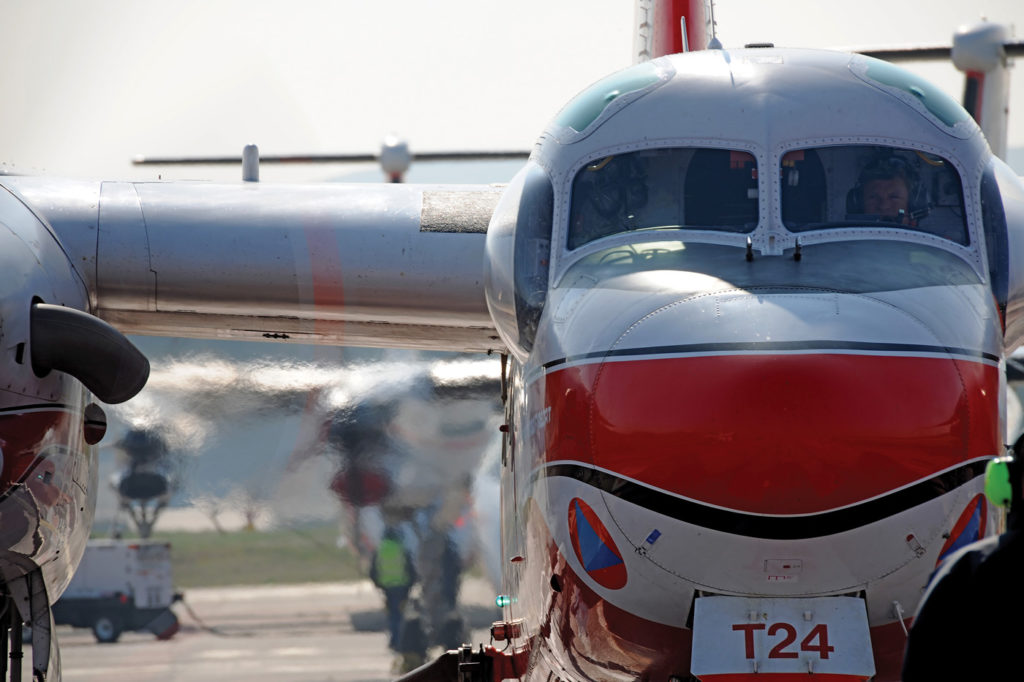
Thus equipped, the Turbo Firecat is the king of the aerial patrol, capable of operating for about two-and-a-half hours at 160 knots, with enough in its holds to knock out any nascent fire.
“The Sécurité Civile’s GAAR mission [Guet Aérien Armé – Armed aerial patrol] is unique to France, while other countries only focus on firefighting,” noted Prioult. “The territory on which we intervene, southern France and Corsica island, lends itself well to the mission.”
The establishment of summer detachments on remote airstrips allows the force to effectively cover its territory with the possibility of intervening very quickly at the scene of a brewing fire.
“When the risks are high, days of great drought with wind, we maintain patrols in the air for two-and-a-half or three hours, with the autonomy necessary to ensure a hand over between a patrol and its backup,” said Prioult. “This organization makes it possible to intervene at any point in the surveillance zone in less than 10 minutes.”
DANGER AND COMPLEXIT
Some days, patrolling an empty sky for hours is a bit boring. The Turbo Firecat pilots do not hide it. But the GAAR mission is like fighting in a war: the passage from the deepest torpor to the most hectic activity can be traversed in the blink of an eye.
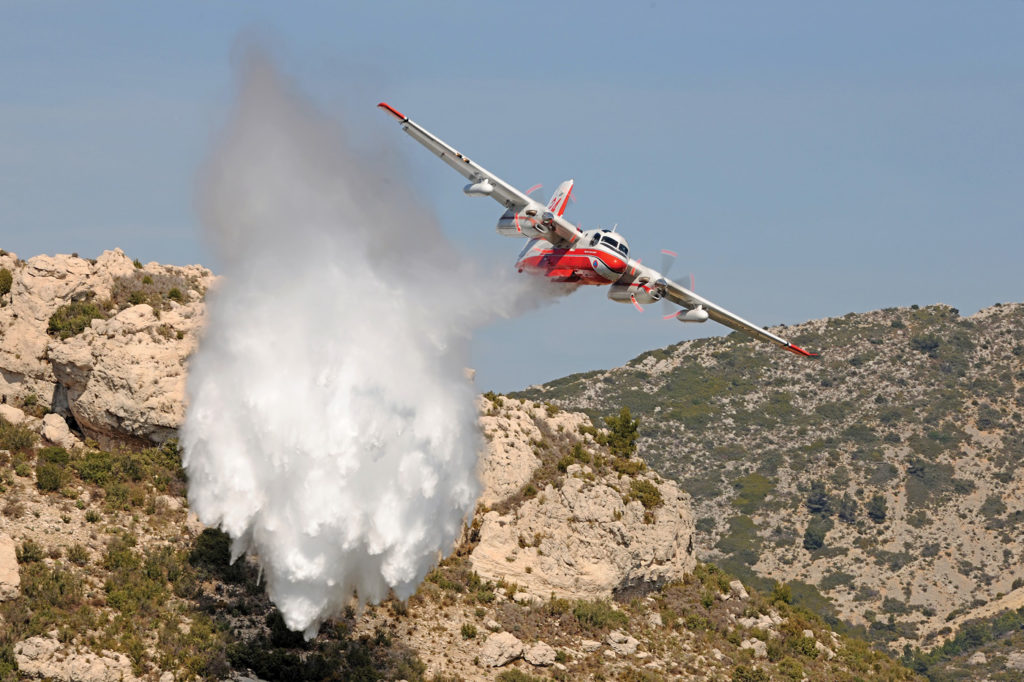
“The principle of the GAAR is to allow us to intervene very quickly; the time factor is essential in the prevention of risks,” said Prioult. “It is necessary to analyze very quickly the fire we face and its environment, so that we can quickly kill it with a drop or two. With a two-aircraft patrol and [a combined six tons] of fire retardant on board, we have the perfect tool to deal with this type of emergency. It is this mission that excites me and which justified my choice of the Turbo Tracker [Firecat].”
When the GAAR is engaged, more than 80 per cent of incipient fires starts are killed by the Turbo Firecat, with the support of ground firefighters. If the initial attack did not succeed in controlling the fire, the airplanes are then used to set retardant barriers to limit its spread or to protect sensitive areas. These things are easily stated, but the reality is often complex and the craft is always dangerous, as evidenced by the eight aircraft lost in flight between 1985 and 2005.
However, the pilots benefit from their previous careers as combat pilots in the air force or the navy. Recruitment is also open to civilians, but a first career within the armed forces is always a major asset. It brings with it a solid knowledge of low-level flight, the sense of relative flying and the ability to think quickly and well in the face of the unexpected.
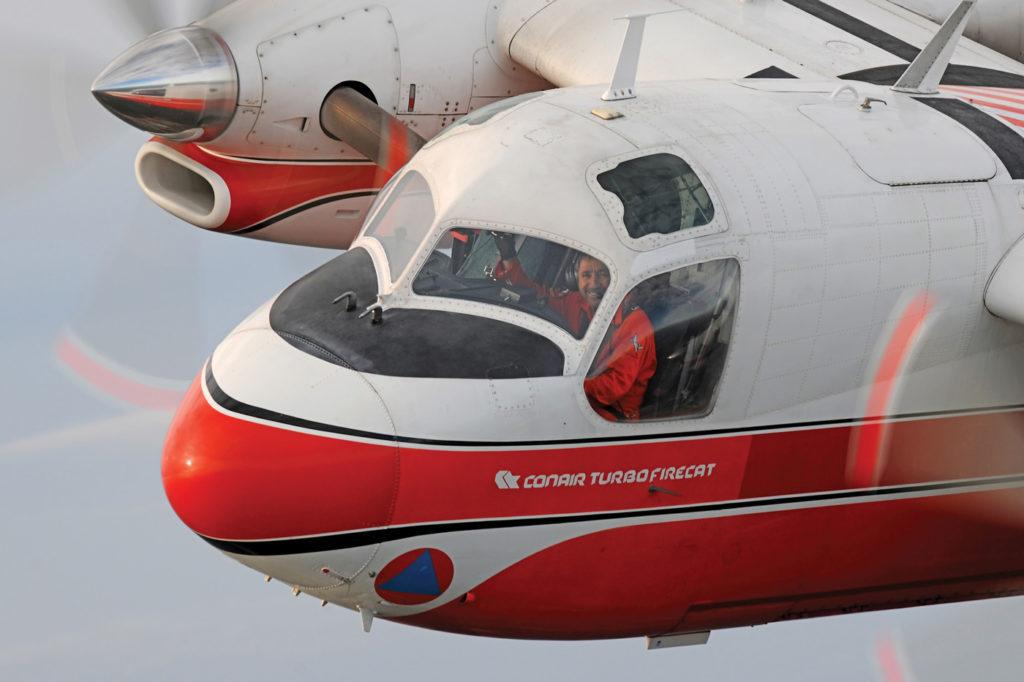
With nine planes available, France’s Turbo Firecat department now has 18 pilots on staff. Recruitment is based on retirements and transfers to the other sectors of the Sécurité Civile, to either the Canadair CL-415s or Bombardier Q400MR multi-role aircraft. A newcomer’s qualification on the Turbo Firecat is made internally, by the department.
Since 2000, new pilots joining the community must acquire two to three years of prior experience as a Canadair CL-415 co-pilot, where they learn their craft of waterbombing and attacking the fires.
STAY TUNED
In 2022, the oldest Turbo Firecat will log 40 years of service under the French colours. Taking into account their past lives, this figure will actually be closer to nearly 70 years of service!
Meanwhile, France prepares to welcome six more Q400MR aircraft to its firefighting fleet.
They will have a tough act to follow.

One of their last two radial powered Firecats was donated to our local museum here in Langley, BC. It was a pleasure to see it fly one last time with the sound of round to accompany it.
Frédéric,
Very well written article but you should take a few minutes to talk with me about the S-2’s replacement and the California Forest Department (CAL FIRE) S-2 Turobprop Trackers which will continue to fly for the next 15 to 20 years.
Cheers
Rick